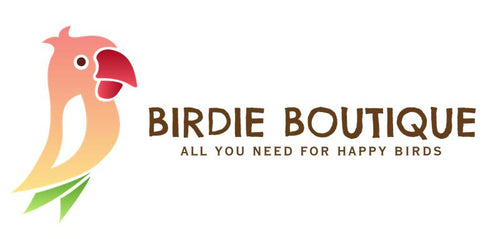Signs of a Sick Bird & When to See the Avian Vet
By Dr. Greg Burkett, Board Certified Avian Veterinarian
Birds are masters at hiding their signs of illness. Pretending to feel well is an instinctual survival mechanism. If a bird in a flock is sick and the flock mates are aware, the sick bird will be chased away and even physically attacked in order to cull the sick bird from the flock. Sick birds attract predators; culling the sick ones protects the rest of the flock.
Captive pet birds exhibit the same instinctual behaviors. Birds can act as if they are normal and feeling well by becoming alert and active when you enter the room or pay attention to them. To appear well, they may vocalize slightly, they will sleek their feathers, or they might stretch to greet you. They will even pretend to eat by crunching food without actually ingesting it. These behaviors make it difficult to tell when your bird is sick, often until it is too late. Typically, a bird is sick for 2-3 days before displaying any obvious signs of illness. If this amount of time has passed for a sick bird, it has become an emergency situation and your bird needs to be seen by an avian veterinarian immediately.
Specific symptoms of a sick bird vary depending on the illness. Some diseases have specific signs that indicate that specific disease. However, it is more often the case that your bird will show general signs of illness, which are exhibited regardless of the cause of illness. There is an extensive list of general symptoms. Some symptoms occur early in the disease process and are elusive. These initial symptoms can quickly become more serious and develop into life-threatening illness. Being able to recognize the early subtle symptoms can make the difference between life and death.
The early symptoms are subtle and often missed. If you notice any symptoms your bird should be seen as soon as possible; the same day is best, or the next day at the latest. Waiting longer to see if your bird improves will only make the bird worse and jeopardize you bird’s life. Waiting will also make diagnosis and treatment by your veterinarian more difficult.
Usually, the earliest indication of illness is that your bird becomes quiet. If your bird is typically vocal, like chirping, singing, squawking, or talking, then suddenly becomes quiet, especially during those times when you expect your bird to be vocal or noisy, then you should make an appointment to be seen within 1-2 days at the latest. There may also be changes in temperament or demeanor, such as a bird that does not like to be handled and suddenly allows petting and touching, or a bird that is normally affectionate becomes grouchy or even aggressive.
A sick bird will sit on the same perch for most, if not all, of the day. An indication is a buildup of droppings underneath the perching spot, with very few or no droppings at all in the rest of the cage.
When your bird is healthy, you should be monitoring droppings to become familiar with what is normal for your bird, and you should take a normal sample with you when you have your bird seen by an avian veterinarian for well-bird annual exams. You should be aware of the normal size of the droppings, the typical color, shape and consistency, and how many per day there are in the bottom of the cage. Knowing what normal droppings look like helps you to notice when they are abnormal. A normal dropping has three different parts: the green portion is feces, which is from the GI tract; the white portion is urates, which is from the kidneys; and the liquid portion is urine, also from the kidneys. Normal droppings will be firm and formed, have slightly more green than white, and will have a small amount of urine that is just enough to make the dropping shiny or cause a small halo of moisture surrounding the dropping. Droppings can vary, depending on many factors, such as what your bird has been eating, whether your bird is molting, if your bird is reproductively active (laying eggs or not), or what time of day they are passed. For example, morning droppings are typically larger, looser, and may even have a slight odor. This variability should only be seen irregularly, with normal droppings occurring as the vast majority. When abnormal droppings occur consistently, i.e., most, if not all, droppings are abnormal, it is an indication that your bird is sick.
Another early symptom is decreased appetite (anorexia), or more likely, not eating at all. Keep in mind that birds will actually pretend to eat. The most accurate methods to determine if your bird is eating are: 1) monitoring weight; 2) monitoring droppings; and 3) observing for visible signs of eating. The most accurate of these methods is to monitor your bird’s weight. For this method to be useful, you will need to know your bird’s normal weight by weighing regularly. I recommend weighing weekly for a healthy bird, keeping a log of the weights for reference. You will need a scale that weighs in grams at 1-2 gram increments for the most accurate results. If you suspect that your bird is ill, then daily weights are necessary. If your bird loses weight three days in a row, or loses ten per cent of body weight in five days or less, it is an indication that your bird is not eating.
The second method to determine if your bird is eating is by monitoring droppings. Dark green to black droppings are an indication that your bird is anorexic (not eating). When droppings look like this, you need to have your bird seen that day or the next day at the latest. Other changes in droppings that indicate anorexia include complete absence of droppings, small droppings, droppings without feces, fewer droppings, and yellow stained urates and/or urine. You may also see diarrhea (loose feces), excessive urine (often confused with diarrhea), or droppings adhered to the feathers on the underside of the tail and around the vent. It is very important to inform your avian veterinarian about the changes in the droppings, and, if possible, take the in paper from the cage over the prior 24-48 hours. Do not clean your cage before taking your bird in. Do not use litters, shavings, corncob, walnut shells, or other bedding material in the tray because these will not allow you to see and assess the droppings. Bedding material is also a health hazard because it produces dust; it may contain toxic chemicals, and can quickly grow bacteria and fungi. Only flat paper should be used to line the tray.
The most inaccurate method of determining if your bird is eating is by monitoring food intake. You can look to see if there is less food in the bowl from the time it was last filled. Evidence of eating can be observed by seeing crumbs or empty seed hulls in or around the bowl and on the cage bottom. If you actually witness your bird eating, keep in mind that your bird may be pretending to eat.
Another symptom exhibited by a sick bird is fluffed feathers. Birds will fluff their feathers, squat over both feet to cover them with feathers, and have their beak tucked over their back underneath the wing all to conserve energy and heat, and maintain their body temperature at ~ 105ºF. This presentation indicates that your bird no longer has enough energy to stay alert, awake, and continue pretending to feel well. Birds in this condition are usually on the bottom of the cage instead of on a perch. If your bird shows these symptoms it is an emergency situation and your bird is likely in critical condition. Other postures exhibited by a sick bird include drooping tail or wings, leaning forward on the perch, leaning on the cage bars, or hanging by his or her beak from the side of the cage.
The aforementioned are earlier signs of illness. The following list is more comprehensive and contains other signs that are typically more apparent. Subtle signs are often missed and should be acted upon as soon as they are noticed. Obvious signs of illness indicate your bird has progressed into a more serious condition and should be treated as an emergency with an immediate visit to your avian veterinarian.
Comprehensive list of Signs of a Sick Bird
• Quiet, not vocalizing
• Change in temperament or demeanor
• Poor or no response to stimuli
• Sitting in one spot for an extended time
• Changes in droppings: diarrhea (loose feces), dark green to black feces, absence of feces, excessive urine, presence of only urates, color change, blood in the droppings, unusual odor
• Not eating or pretending to eat
• Weight loss or prominent keel (breast bone)
• Fluffed feathers
• Abnormal posture
• Sitting on the bottom of the cage
• Change in respiratory rate
• Difficulty breathing (dyspnea)
• Open-mouthed breathing
• Respiratory noises – coughing, sneezing, wheezing, gurgling
• Tail bobbing when breathing
• Change in voice
• Crusting around or discharge from eyes, mouth, or nares (nostrils)
• Drooping or nonfunctioning limb
• Droppings matted to the feathers underneath the tail and/or around the vent
• Partially closed, almond-shaped eyes (normally round and open)
• Regurgitating or vomiting
• Wet, stained, or matted head feathers
• Head flicking or shaking
• Not preening or poorly preened feathers
• Dull lack-luster feathers
• Changes in feather color
• Excessive time spent molting
• Any visible bleeding
• Over-grown or crooked nails or beak
• Weakness, loss of balance (ataxia), falling from perch
• Being harassed by cage mates
• Redness or feather loss around eyes
• Straining (tenesmus) such as to pass an egg or droppings
• Protrusion (of tissue or egg) from the vent
• Swelling of any body part
• Bare spots or abnormal featherless areas
Regular veterinary visits for well-bird checkups are vital for maintaining a healthy bird. At minimum your bird should be examined annually. Having your bird seen when he or she is healthy is important for three main reasons: 1) To allow your veterinarian to see how your bird looks when he or she is well, making it easier to determine when your bird is sick; 2) To establish normal lab values for comparison to those taken when illness is suspected 3) To screen your bird for health problems that he or she may be hiding. Your avian veterinarian is trained and experienced to see these subtle signs of illness that are frequently missed at home. Annual visits for a healthy bird should include: a) A thorough physical examination including a body weight in grams (not ounces); b) Base-line blood work to establish normal white and red blood cell counts, normal parameters for physiological processes such as liver, kidney, and other organ function, and to screen for blood parasites; c) A fecal Gram’s stain to see normal flora bacteria and yeast counts; d) Vaccination for Avian Polyomavirus; and e) A radiograph (x-ray) to seen the normal size of organs.

